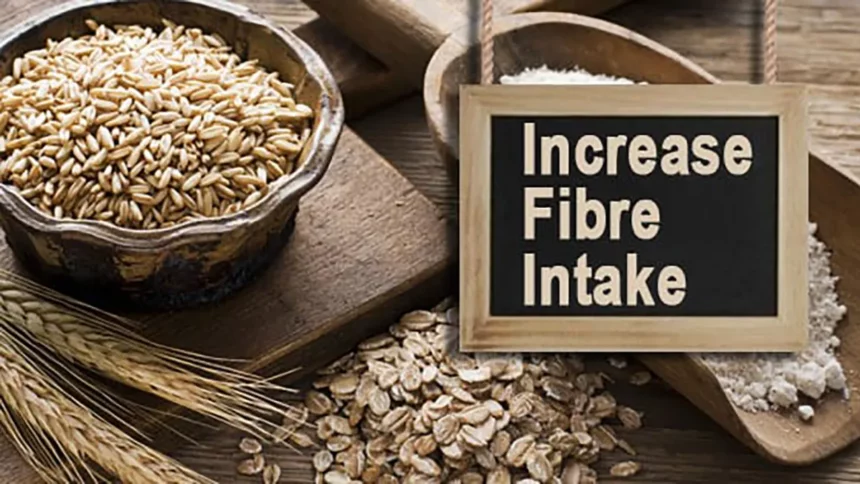Dietary fibre, also known as roughage includes the parts of plant foods your body can’t digest or absorb. Unlike other food components, such as fats, proteins or carbohydrates — that your body breaks down and absorbs — fibre is not digested by your body. Instead, it passes relatively intact through your stomach, small intestine and colon and out of your body. While that sounds fairly unsettling, this is a good thing because it helps regulate your digestive system and reduces your risk of getting constipation.
Eating fibre also supports heart health, and helps maintain blood sugar levels. Increasing your fibre intake can also aid in weight loss.
Read also: Health Benefits of Eating Fibre
Fibre is commonly classified as soluble, which dissolves in water, or insoluble, which doesn’t dissolve in water.
- Soluble fibre: This type of fibre dissolves in water to form a gel-like material. It can help lower blood cholesterol and glucose levels. Soluble fibre is found in oats, peas, beans, apples, citrus fruits, carrots, and barley.
- Insoluble fibre: This type of fibre promotes the movement of material through your digestive system and increases stool bulk, so it can be of benefit to those who struggle with constipation or irregular stools. Whole-wheat flour, wheat bran, nuts, beans and vegetables, such as cauliflower, green beans and potatoes, are good sources of insoluble fibre.
Most plant-based foods, such as oatmeal and beans, contain both soluble and insoluble fibre. However, the amount of each type varies in different plant foods. To receive the greatest health benefit, eat a wide variety of high-fibre foods.
How much Fibre do you need?
According to the Indian Council of Medical Research, an average Indian adult consumes only 14 grams of fibre every day while the recommended daily allowance is 25 -30 grams for adult women and 38 grams for adult men. It is important to introduce fibre into your diet gradually and ensure that you drink adequate amounts of fluid. Introducing too much fibre too quickly or eating too much fibre (in excess of 60g a day) may cause constipation or diarrhea in some people.
Many of the most common, and tastiest, Indian dishes are high in dietary fibre and other key nutrients you need for good health. We’ve put together 6 easy ways to help you increase your fibre intake while adding flavour and variety to your diet.
1. Begin your day with a fibre boost
You’ve probably heard that breakfast is the most important meal of the day, but starting your day with the right kind of fuel is equally important. Choose breakfast cereals with at least 3 gms of fibre per serving. Opt for whole-wheat toast, or grab a handful of fiber-rich berries.
You can also mix a tablespoon full of Nutriplus Fibrefit into a glass of water and drink it to round off a healthy breakfast and get your daily dose of fibre.
2. Pick whole grain foods over refined carbohydrates
Whole grain foods are a natural source of dietary fibre. Unlike refined carbohydrates (think white bread), whole grains retain the kernel’s fiber-rich outer shell, known as bran. Grains, such as rice and whole-wheat flour, have prominent roles in Indian cuisine, and many of these grains supply a good dose of fibre, as well.
For example, naan and chapati are often made with whole-wheat flour. A cup of whole-wheat flour contains 12.8 gms of fibre. Brown rice is also a star ingredient in many Indian dishes, such as Rajma Chawal. One cup of brown rice delivers 3.5 gms of fibre. Puttu, which is ground rice, as well as rice pancakes, are additional examples of grain-based Indian foods high in fibre.
3. Pick high-fiber snacks when the midday munchies hit
Avoid high-calorie, high-fat and low-fiber snacks from the junk food aisle of the supermarket by packing fiber-rich snacks in your bag. Perfect answers to an afternoon slump include whole grain crackers, granola bars, homemade trail mix, mixed nuts, low-fat popcorn, and dried figs or apricots.
4. Add fresh fruit to every meal
Whether added to cereal, eaten as a snack, or enjoyed as a simple dessert, fresh fruit is a sweet way to add fibre to your diet. The fruits highest in fibre include apples, berries, prunes, pears and oranges.
5. Load up on legumes
High-fibre legumes like beans, peas, and lentils – are among the best sources of fibre. Legumes have a starring role in many of the most common Indian dishes, and they are also high in fibre, as well as low in fat. Dal, made with lentils or split peas, is one example. A cup of cooked lentils contains 15.6 gms of fibre and a cup of split peas contains 16.3 gms. Rajma is another common Indian dish and it’s made with kidney beans, which provide 13.6 gms of fibre per cup. Chickpeas are another ingredient used in many Indian dishes, and they supply 12.5 gms of fibre per cup.
6. Eat a variety of veggies
Vegetables are a good source of fiber, and many of them are included in Indian cuisine. For example, ladies finger (bhindi) is a common addition to many Indian dishes and 1 cup of the vegetable supplies 4 gms of fibre. Potatoes are included in many Indian recipes, such as aloo gobhi, and a cup of boiled potatoes without the skin contains 2.8 gms of fibre. Cauliflower is also included in aloo gobhi and a cup of the vegetable supplies about 5 gms of fibre. Brinjal and cabbage are additional examples of fiber-rich vegetables that appear in Indian soups and stews.








